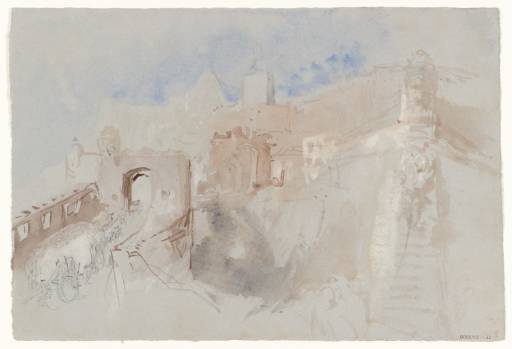Joseph Mallord William Turner The Entrance to Veste Coburg 1840
Joseph Mallord William Turner,
The Entrance to Veste Coburg
1840
Joseph Mallord William Turner 1775–1851
The Entrance to Veste Coburg 1840
D32190
Turner Bequest CCCXVII 11
Turner Bequest CCCXVII 11
Pencil, watercolour and gouache on grey wove paper, 190 x 278 mm
Blind-stamped with Turner Bequest monogram towards bottom right
Inscribed in red ink ‘11’ bottom right
Stamped in black ‘CCCXVII – 11’ bottom right
Blind-stamped with Turner Bequest monogram towards bottom right
Inscribed in red ink ‘11’ bottom right
Stamped in black ‘CCCXVII – 11’ bottom right
Accepted by the nation as part of the Turner Bequest 1856
Exhibition history
1995
Turner in Germany, Tate Gallery, London, May–September 1995, Städtische Kunsthalle Mannheim, September 1995–January 1996, Hamburger Kunsthalle, Hamburg, January–March 1996 (101, as ‘The Entrance to Veste Coburg’, 1840, reproduced).
References
1909
A.J. Finberg, A Complete Inventory of the Drawings of the Turner Bequest, London 1909, vol.II, p.1023, CCCXVII 11, as ‘Fortress, with drawbridge’.
1930
A.J. Finberg, In Venice with Turner, London 1930, p.175, as possible Tyrol subject.
1995
Cecilia Powell, Turner in Germany, exhibition catalogue, Tate Gallery, London 1995, pp.81 note 2, 145 under no.67, 169 under no.98, 172 no.101, as ‘The Entrance to Veste Coburg’, 1840, reproduced.
2001
Cecilia Powell, ‘Coburg’ in Evelyn Joll, Martin Butlin and Luke Herrmann eds., The Oxford Companion to J.M.W. Turner, Oxford 2001, p.50.
Turner was in Coburg, then capital of the German Duchy of Saxe-Coburg-Gotha, between 17 and 20 September 1840, and made many drawings of the town and its surroundings in the Venice; Passau to Würzburg sketchbook; see under Tate D31278 (Turner Bequest CCCX 1a). Cecilia Powell identified the present colour study as showing the approach to the south side of the medieval Veste Coburg fortress, high up in parkland north-east of the town, comparing it in particular with a pencil sketch in the book (D31400; CCCX 63).1
Powell has noted that the composition ‘gives a good impression of the very steep ascent ... and the vast size of its walls and bastions’ with the ‘“Bunter Löwe” bastion, surmounted by a turret and adorned with a huge stone cartouche depicting a lion flanked by griffons’ in the right foreground, as ‘a heavily laden wagon slowly crawls up the steep path on the left’,2 with the similar ‘Rautenkranz’ bastion beyond. Compared with the pencil sketch, this version gives more prominence to the plain arch spanning the road than to the heavily articulated Baroque portal reached by a short bridge over the ravine at the centre, and the walls and towers beyond are hardly developed.
This is one of four colour studies on grey paper of the Coburg area, which can all be related to Venice; Passau to Würzburg pencil sketches (see also Tate D32186, D32187 and D32188; Turner Bequest CCCXVII 7, 8, 9); there are additionally three loose watercolours on conventional white sheets (D35889, D35948, D36187; CCCLXIV 49, 105, 329).3 D32188 shows Veste Coburg in its wider hilltop setting.
Originally described as showing a ‘Fortress, with drawbridge’,4 this sheet had nevertheless been included in the ‘Venice: Miscellaneous. (b) Grey Paper’ section of Finberg’s 1909 Inventory, albeit among a handful (Tate D32185–D32191; Turner Bequest CCCXVII 6–12) of which he noted ‘some – probably all ... are not Venetian subjects’, but likely ‘done at the same time, and may therefore help to throw light on Turner’s movements.’5 In 1930 he noted that ‘some ... may have been made in the Tyrol on the way to or from Venice’.6 Other than D32189, a view of Bolzano (Bozen) from the outward leg, and D32191, which may show the Venetian Lagoon, they have all since been identified as German subjects from 1840’s return journey, and are included in this subsection (see also the technical notes).
Technical notes:
Pencil work appears limited to the top of the central tower, and the cart in the foreground, other details being delineated in with touches of wash.
Among many such works on the blue or grey papers customarily used by Turner, this is one of five originally from a single piece (Tate D32186–D32188, D32190, D36158; Turner Bequest CCCXVII 7–9, 11; CCCLXIV 301) to be identified by Cecilia Powell as showing Coburg and Würzburg subjects.1 They are neatly torn eighths of a sheet of grey Bally, Ellen and Steart paper, likely made in 18292 (albeit none of these sections bears a watermark), of the type often used in 1840 (see the Introduction to the overall tour).3
Noting Finberg’s provisional mingling of then unidentified German views with Venice subjects in the 1909 Inventory, as discussed above, Powell concurred that ‘there are, indeed, strong resemblances of both palette and expression between the four Coburg [and single Würzburg] drawings and the much larger Venetian group’, and suggested that the other three eights of the sheet had likely been used in Venice,4 although this possibility was not addressed specifically in Ian Warrell’s subsequent checklist of the Bally, Ellen and Steart sheets Turner used there.5
See also Peter Bower, Turner’s Later Papers: A Study of the Manufacture, Selection and Use of his Drawing Papers 1820–1851, exhibition catalogue, Tate Gallery, pp.105, 107, for discussion of another such group, comprising seven Regensburg and Walhalla views included in the present subsection.
Verso:
Blank; inscribed in pencil ‘CCCXVII.11’ bottom right.
Matthew Imms
September 2018
How to cite
Matthew Imms, ‘The Entrance to Veste Coburg 1840 by Joseph Mallord William Turner’, catalogue entry, September 2018, in David Blayney Brown (ed.), J.M.W. Turner: Sketchbooks, Drawings and Watercolours, Tate Research Publication, December 2019, https://www

